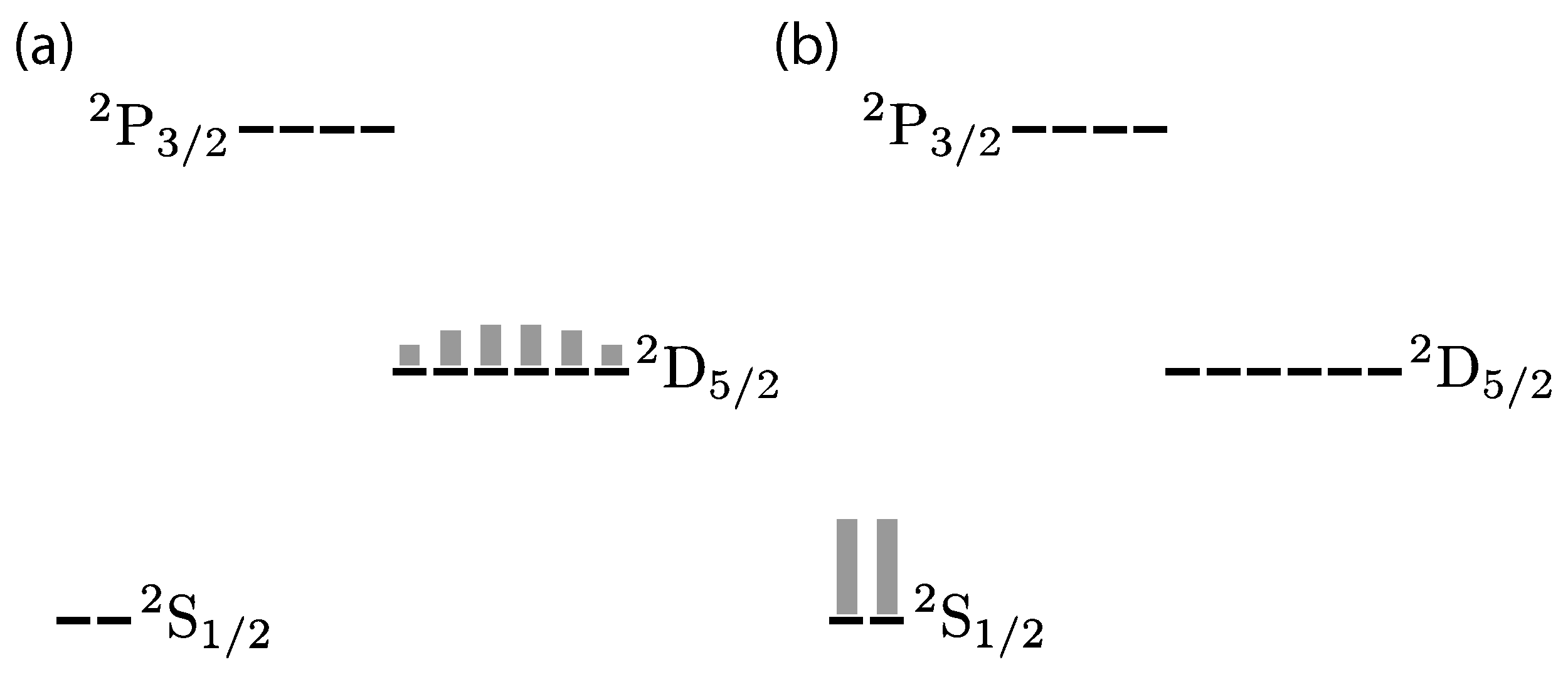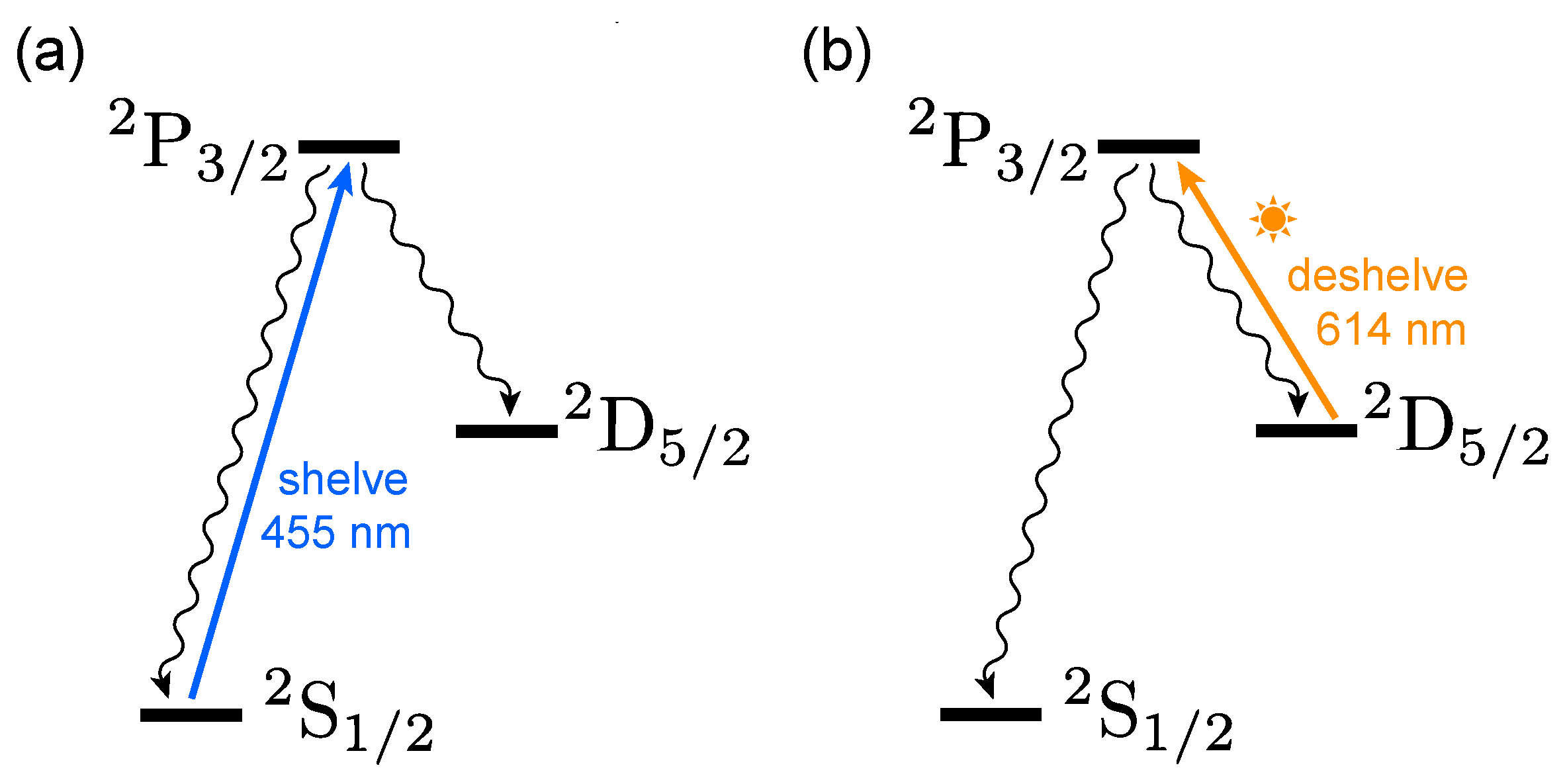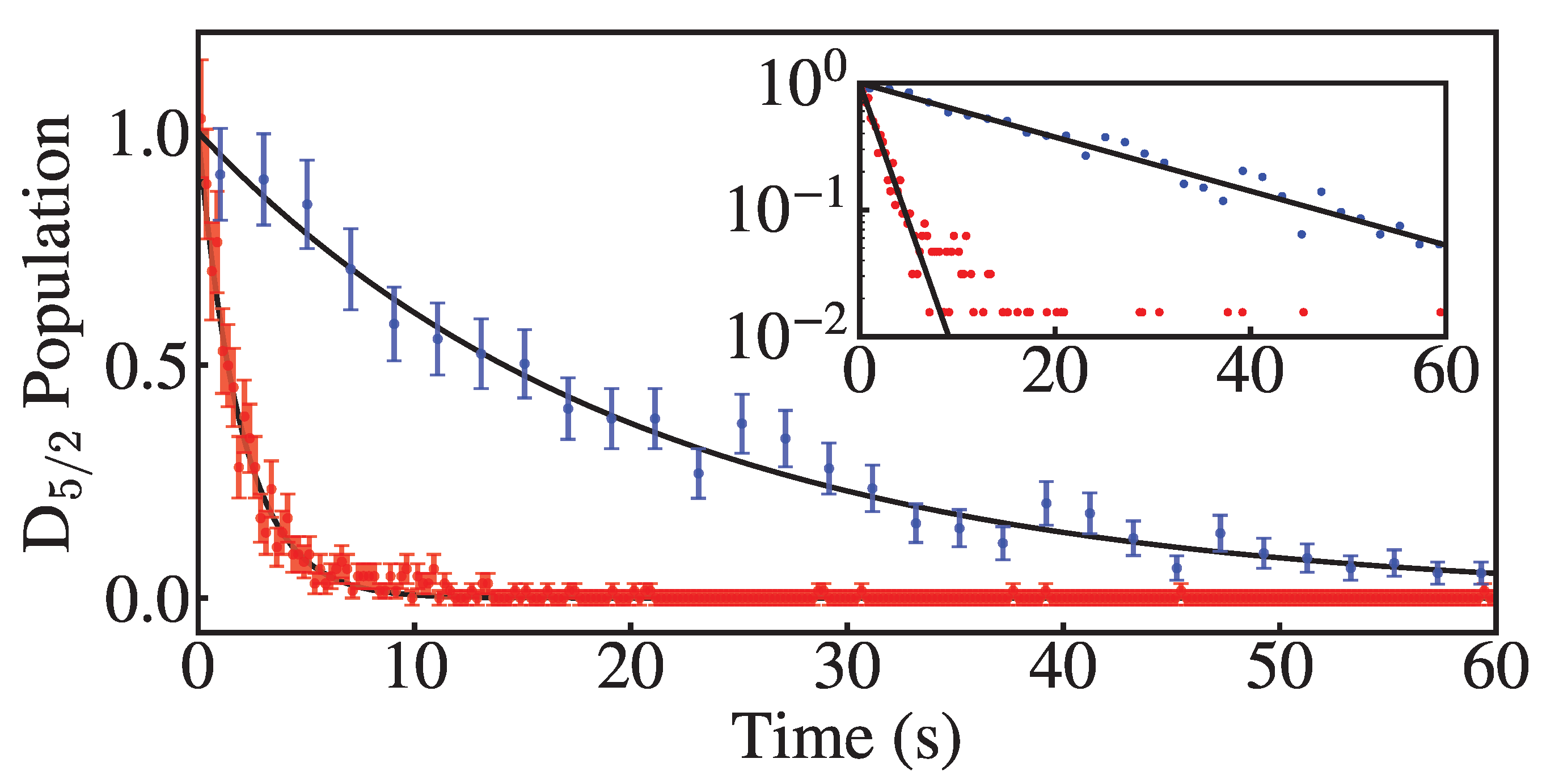Internal State Cooling of an Atom with Thermal Light
Abstract
1. Introduction
2. Internal State Cooling of a Barium Ion
3. Experimental Demonstration
Measured Cooling Rates
Author Contributions
Funding
Institutional Review Board Statement
Data Availability Statement
Acknowledgments
Conflicts of Interest
References
- Tscherbul, T.V.; Brumer, P. Excitation of biomolecules with incoherent light: Quantum yield for the photoisomerization of model retinal. J. Phys. Chem. A 2014, 118, 3100. [Google Scholar] [CrossRef] [PubMed]
- Tscherbul, T.V.; Brumer, P. Long-lived quasistationary coherences in a V-type system driven by incoherent light. Phys. Rev. Lett. 2014, 113, 113601. [Google Scholar] [CrossRef] [PubMed]
- Tscherbul, T.V.; Brumer, P. Quantum coherence effects in natural light-induced processes: Cis- Photoisomerization Model Retin. Incoherent Excit. Phys. Chem. Chem. Phys. 2015, 17, 30904. [Google Scholar] [CrossRef] [PubMed]
- Olšina, J.; Dijkstra, A.G.; Wang, C.; Cao, J. Can natural sunlight induce coherent exciton dynamics? arXiv 2014, arXiv:1408.5385. [Google Scholar]
- Brumer, P. Shedding (incoherent) light on quantum effects in light-induced biological processes. J. Phys. Chem. Lett. 2018, 9, 2946. [Google Scholar] [CrossRef] [PubMed]
- Cao, J.; Cogdell, R.J.; Coker, D.F.; Duan, H.G.; Hauer, J.; Kleinekathöfer, U.; Jansen, T.L.C.; Mančal, T.; Miller, R.J.D.; Ogilvie, J.P.; et al. Quantum biology revisited. Sci. Adv. 2020, 6, eaaz4888. [Google Scholar] [CrossRef]
- Chuang, C.W.; Brumer, P. LH1–RC light-harvesting photocycle under realistic light–matter conditions. J. Chem. Phys. 2020, 152, 154101. [Google Scholar] [CrossRef]
- Dodin, A.; Brumer, P. Noise-induced coherence in molecular processes. J. Phys. B At. Mol. Opt. Phys. 2021, 54, 223001. [Google Scholar] [CrossRef]
- Chuang, C.W.; Brumer, P. Steady state photoisomerization quantum yield of model rhodopsin: Insights from wavepacket dynamics. J. Phys. Chem. Lett. 2022, 13, 4963. [Google Scholar] [CrossRef] [PubMed]
- Scully, M.O.; Chapin, K.R.; Dorfman, K.E.; Kim, M.B.; Svidzinsky, A. Quantum heat engine power can be increased by noise-induced coherence. Proc. Natl. Acad. Sci. USA 2011, 108, 15097. [Google Scholar] [CrossRef] [PubMed]
- Dorfman, K.E.; Voronine, D.V.; Mukamel, S.; Scully, M.O. Photosynthetic reaction center as a quantum heat engine. Proc. Natl. Acad. Sci. USA 2013, 110, 2746. [Google Scholar] [CrossRef] [PubMed]
- Kosloff, R.; Levy, A. Quantum heat engines and refrigerators: Continuous devices. Annu. Rev. Phys. Chem. 2014, 65, 365–393. [Google Scholar] [CrossRef] [PubMed]
- Gallagher, T.F.; Cooke, W.E. Interactions of Blackbody Radiation with Atoms. Phys. Rev. Lett. 1979, 42, 835–839. [Google Scholar] [CrossRef]
- Dunbar, R.C. Kinetics of low-intensity infrared laser photodissociation. The thermal model and application of the Tolman theorem. J. Chem. Phys. 1991, 95, 2537–2548. [Google Scholar] [CrossRef]
- Hechtfischer, U.; Amitay, Z.; Forck, P.; Lange, M.; Linkemann, J.; Schmitt, M.; Schramm, U.; Schwalm, D.; Wester, R.; Zajfman, D.; et al. Near-Threshold Photodissociation of Cold CH+ in a Storage Ring. Phys. Rev. Lett. 1998, 80, 2809–2812. [Google Scholar] [CrossRef]
- Beloy, K.; Safronova, U.I.; Derevianko, A. High-accuracy calculation of the blackbody radiation shift in the 133Cs primary frequency standard. Phys. Rev. Lett. 2006, 97, 040801. [Google Scholar] [CrossRef]
- Hoekstra, S.; Gilijamse, J.J.; Sartakov, B.; Vanhaecke, N.; Scharfenberg, L.; van de Meerakker, S.Y.T.; Meijer, G. Optical Pumping of Trapped Neutral Molecules by Blackbody Radiation. Phys. Rev. Lett. 2007, 98, 133001. [Google Scholar] [CrossRef] [PubMed]
- Ovsiannikov, V.D.; Derevianko, A.; Gibble, K. Rydberg spectroscopy in an optical lattice: Blackbody thermometry for atomic clocks. Phys. Rev. Lett. 2011, 107, 093003. [Google Scholar] [CrossRef] [PubMed]
- Safronova, M.S.; Kozlov, M.G.; Clark, C.W. Blackbody radiation shifts in optical atomic clocks. IEEE Trans. Ultrason. Ferroelectr. Freq. Control 2012, 59, 439. [Google Scholar] [CrossRef]
- Haslinger, P.; Jaffe, M.; Xu, V.; Schwartz, O.; Sonnleitner, M.; Ritsch-Marte, M.; Ritsch, H.; Müller, H. Attractive force on atoms due to blackbody radiation. Nat. Phys. 2018, 14, 257–260. [Google Scholar] [CrossRef]
- Lisdat, C.; Dörscher, S.; Nosske, I.; Sterr, U. Blackbody radiation shift in strontium lattice clocks revisited. Phys. Rev. Res. 2021, 3, L042036. [Google Scholar] [CrossRef]
- Festa, L.; Lorenz, N.; Steinert, L.M.; Chen, Z.; Osterholz, P.; Eberhard, R.; Gross, C. Blackbody-radiation-induced facilitated excitation of Rydberg atoms in optical tweezers. Phys. Rev. A 2022, 105, 013109. [Google Scholar] [CrossRef]
- Koyu, S.; Dodin, A.; Brumer, P.; Tscherbul, T.V. Steady-state Fano coherences in a V-type system driven by polarized incoherent light. Phys. Rev. Res. 2021, 3, 013295. [Google Scholar] [CrossRef]
- Dodin, A.; Tscherbul, T.; Alicki, R.; Vutha, A.; Brumer, P. Secular versus nonsecular Redfield dynamics and Fano coherences in incoherent excitation: An experimental proposal. Phys. Rev. A 2018, 97, 013421. [Google Scholar] [CrossRef]
- Koyu, S.; Tscherbul, T.V. Long-lived quantum coherent dynamics of a Λ-system driven by a thermal environment. J. Chem. Phys. 2022, 157, 124302. [Google Scholar] [CrossRef]
- Mari, A.; Eisert, J. Cooling by Heating: Very Hot Thermal Light Can Significantly Cool Quantum Systems. Phys. Rev. Lett. 2012, 108, 120602. [Google Scholar] [CrossRef]
- Cleuren, B.; Rutten, B.; Van den Broeck, C. Cooling by Heating: Refrigeration Powered by Photons. Phys. Rev. Lett. 2012, 108, 120603. [Google Scholar] [CrossRef]
- Pobell, F. Matter and Methods at Low Temperatures, 2nd ed.; Springer: Berlin, Germany, 1996. [Google Scholar]
- Ma, Y.; Yin, Z.Q.; Huang, P.; Yang, W.L.; Du, J. Cooling a mechanical resonator to the quantum regime by heating it. Phys. Rev. A 2016, 94, 053836. [Google Scholar] [CrossRef]
- Rossatto, D.Z.; de Almeida, A.R.; Werlang, T.; Villas-Boas, C.J.; de Almeida, N.G. Cooling by heating in the quantum optics domain. Phys. Rev. A 2012, 86, 035802. [Google Scholar] [CrossRef]
- Younes, A.; Campbell, W.C. Laser-type cooling with unfiltered sunlight. Phys. Rev. E 2024, 109, 034109. [Google Scholar] [CrossRef]
- Dehmelt, H.G. Entropy reduction by motional sideband excitation. Nature 1976, 262, 777. [Google Scholar] [CrossRef]
- Wineland, D.; Dehmelt, H. Proposed 10−14 Δν < ν laser fluorescence spectroscopy on Tl+ mono-ion oscillator III. Bull. Am. Phys. Soc. 1975, 20, 637. [Google Scholar]
- Diedrich, F.; Bergquist, J.C.; Itano, W.M.; Wineland, D.J. Laser Cooling to the Zero-Point Energy of Motion. Phys. Rev. Lett. 1989, 62, 403–406. [Google Scholar] [CrossRef] [PubMed]
- Hamann, S.E.; Haycock, D.L.; Klose, G.; Pax, P.H.; Deutsch, I.H.; Jessen, P.S. Resolved-Sideband Raman Cooling to the Ground State of an Optical Lattice. Phys. Rev. Lett. 1998, 80, 4149–4152. [Google Scholar] [CrossRef]
- Teufel, J.D.; Donner, T.; Li, D.; Harlow, J.W.; Allman, M.S.; Cicak, K.; Sirois, A.J.; Whittaker, J.D.; Lehnert, K.W.; Simmonds, R.W. Sideband cooling of micromechanical motion to the quantum ground state. Nature 2011, 475, 359–363. [Google Scholar] [CrossRef] [PubMed]
- Fohrmann, L.S.; Petrov, A.Y.; Lang, S.; Jalas, D.; Krauss, T.F.; Eich, M. Single mode thermal emission. Opt. Express 2015, 23, 27672–27682. [Google Scholar] [CrossRef]
- De Vos, A. Thermodynamics of radiation energy conversion in one and in three physical dimensions. J. Phys. Chem. Solids 1988, 49, 725–730. [Google Scholar] [CrossRef]
- Landsberg, P.T.; Vos, A.D. The Stefan-Boltzmann constant in n-dimensional space. J. Phys. A Math. Gen. 1989, 22, 1073. [Google Scholar] [CrossRef]
- Alnes, H.; Ravndal, F.; Wehus, I.K. Black-body radiation with extra dimensions. J. Phys. A Math. Theor. 2007, 40, 14309. [Google Scholar] [CrossRef]
- Nagourney, W.; Sandberg, J.; Dehmelt, H. Shelved optical electron amplifier: Observation of quantum jumps. Phys. Rev. Lett. 1986, 56, 2797–2799. [Google Scholar] [CrossRef] [PubMed]
- Madej, A.A.; Sankey, J.D. Quantum jumps and the single trapped barium ion: Determination of collisional quenching rates for the 5d2D5/2 level. Phys. Rev. A 1990, 41, 2621–2630. [Google Scholar] [CrossRef] [PubMed]
- Auchter, C.; Noel, T.W.; Hoffman, M.R.; Williams, S.R.; Blinov, B.B. Measurement of the branching fractions and lifetime of the 5D3/2 level of Ba+. Phys. Rev. A 2014, 90, 060501. [Google Scholar] [CrossRef]



Disclaimer/Publisher’s Note: The statements, opinions and data contained in all publications are solely those of the individual author(s) and contributor(s) and not of MDPI and/or the editor(s). MDPI and/or the editor(s) disclaim responsibility for any injury to people or property resulting from any ideas, methods, instructions or products referred to in the content. |
© 2025 by the authors. Licensee MDPI, Basel, Switzerland. This article is an open access article distributed under the terms and conditions of the Creative Commons Attribution (CC BY) license (https://creativecommons.org/licenses/by/4.0/).
Share and Cite
Younes, A.; Putnam, R.; Hamilton, P.; Campbell, W.C. Internal State Cooling of an Atom with Thermal Light. Entropy 2025, 27, 222. https://doi.org/10.3390/e27030222
Younes A, Putnam R, Hamilton P, Campbell WC. Internal State Cooling of an Atom with Thermal Light. Entropy. 2025; 27(3):222. https://doi.org/10.3390/e27030222
Chicago/Turabian StyleYounes, Amanda, Randall Putnam, Paul Hamilton, and Wesley C. Campbell. 2025. "Internal State Cooling of an Atom with Thermal Light" Entropy 27, no. 3: 222. https://doi.org/10.3390/e27030222
APA StyleYounes, A., Putnam, R., Hamilton, P., & Campbell, W. C. (2025). Internal State Cooling of an Atom with Thermal Light. Entropy, 27(3), 222. https://doi.org/10.3390/e27030222





